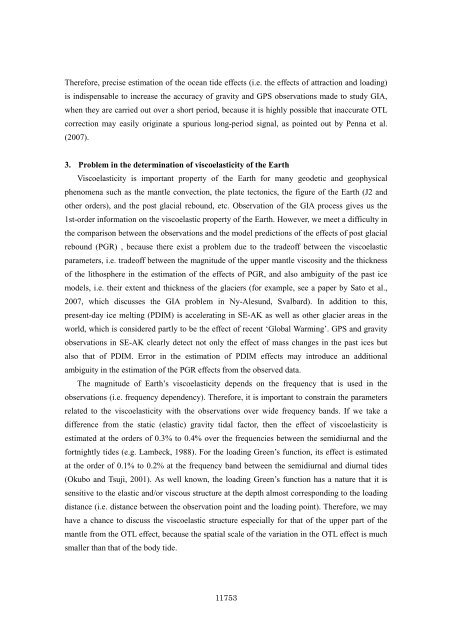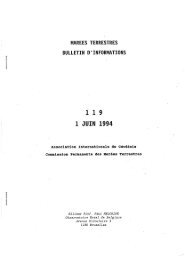marees terrestres bulletin d'informations - Université de la Polynésie ...
marees terrestres bulletin d'informations - Université de la Polynésie ...
marees terrestres bulletin d'informations - Université de la Polynésie ...
You also want an ePaper? Increase the reach of your titles
YUMPU automatically turns print PDFs into web optimized ePapers that Google loves.
Therefore, precise estimation of the ocean ti<strong>de</strong> effects (i.e. the effects of attraction and loading)<br />
is indispensable to increase the accuracy of gravity and GPS observations ma<strong>de</strong> to study GIA,<br />
when they are carried out over a short period, because it is highly possible that inaccurate OTL<br />
correction may easily originate a spurious long-period signal, as pointed out by Penna et al.<br />
(2007).<br />
3. Problem in the <strong>de</strong>termination of viscoe<strong>la</strong>sticity of the Earth<br />
Viscoe<strong>la</strong>sticity is important property of the Earth for many geo<strong>de</strong>tic and geophysical<br />
phenomena such as the mantle convection, the p<strong>la</strong>te tectonics, the figure of the Earth (J2 and<br />
other or<strong>de</strong>rs), and the post g<strong>la</strong>cial rebound, etc. Observation of the GIA process gives us the<br />
1st-or<strong>de</strong>r information on the viscoe<strong>la</strong>stic property of the Earth. However, we meet a difficulty in<br />
the comparison between the observations and the mo<strong>de</strong>l predictions of the effects of post g<strong>la</strong>cial<br />
rebound (PGR) , because there exist a problem due to the tra<strong>de</strong>off between the viscoe<strong>la</strong>stic<br />
parameters, i.e. tra<strong>de</strong>off between the magnitu<strong>de</strong> of the upper mantle viscosity and the thickness<br />
of the lithosphere in the estimation of the effects of PGR, and also ambiguity of the past ice<br />
mo<strong>de</strong>ls, i.e. their extent and thickness of the g<strong>la</strong>ciers (for example, see a paper by Sato et al.,<br />
2007, which discusses the GIA problem in Ny-Alesund, Svalbard). In addition to this,<br />
present-day ice melting (PDIM) is accelerating in SE-AK as well as other g<strong>la</strong>cier areas in the<br />
world, which is consi<strong>de</strong>red partly to be the effect of recent ‘Global Warming’. GPS and gravity<br />
observations in SE-AK clearly <strong>de</strong>tect not only the effect of mass changes in the past ices but<br />
also that of PDIM. Error in the estimation of PDIM effects may introduce an additional<br />
ambiguity in the estimation of the PGR effects from the observed data.<br />
The magnitu<strong>de</strong> of Earth’s viscoe<strong>la</strong>sticity <strong>de</strong>pends on the frequency that is used in the<br />
observations (i.e. frequency <strong>de</strong>pen<strong>de</strong>ncy). Therefore, it is important to constrain the parameters<br />
re<strong>la</strong>ted to the viscoe<strong>la</strong>sticity with the observations over wi<strong>de</strong> frequency bands. If we take a<br />
difference from the static (e<strong>la</strong>stic) gravity tidal factor, then the effect of viscoe<strong>la</strong>sticity is<br />
estimated at the or<strong>de</strong>rs of 0.3% to 0.4% over the frequencies between the semidiurnal and the<br />
fortnightly ti<strong>de</strong>s (e.g. Lambeck, 1988). For the loading Green’s function, its effect is estimated<br />
at the or<strong>de</strong>r of 0.1% to 0.2% at the frequency band between the semidiurnal and diurnal ti<strong>de</strong>s<br />
(Okubo and Tsuji, 2001). As well known, the loading Green’s function has a nature that it is<br />
sensitive to the e<strong>la</strong>stic and/or viscous structure at the <strong>de</strong>pth almost corresponding to the loading<br />
distance (i.e. distance between the observation point and the loading point). Therefore, we may<br />
have a chance to discuss the viscoe<strong>la</strong>stic structure especially for that of the upper part of the<br />
mantle from the OTL effect, because the spatial scale of the variation in the OTL effect is much<br />
smaller than that of the body ti<strong>de</strong>.<br />
11753



